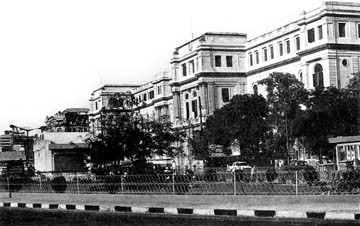Indian Museum, Kolkata
Indian Museum, Kolkata the earliest museum in the Asia Pacific region. Established on 2 February, 1814 at the cradle of the asiatic society, it underwent multi-linear phases of fruitful existence - the periods of germination, accumulation, consolidation and expansion. The Indian Museum that was earlier known as Asiatic Museum and subsequently as Imperial Museum thus grew into the largest institution of its kind in the subcontinent.

With countless objects of art and nature and of infinite variety showcased in the sixty galleries spreading over almost eight thousand square metre area of its six sections- Art, Archaeology, Anthropology, Zoology, Geology and Botany with about one million holdings, this multipurpose institution with its multi-disciplinary activities, is being included as an important national institution in the constitution of the Republic of India. In the year 1866 the governance of the institution was transferred to a body corporate called Trustees of the Indian Museum under Indian Museum Act no. XVII of 1866, which was amended later by Indian Museum Act no X of 1910. The administration of the Indian Museum is at present run in accordance with the Indian Museum Act, 1910, as amended up to 1960.
The foundation of the present Victorian edifice was laid in 1867 and completed in the year 1875, the architect being WL Granville. On 1 April 1878 the museum was thrown open to the public at the present building on Chowringhee Road overlooking the green maidan.
The Archaeology section includes pre and proto-history, Maurya, Shunga, Shatavahana, Gandhara, Kusana, Gupta, Pala-Sena, Chandela, Hoysala, Chola art galleries besides the minor antiquity collections through the ages. A modest collection of Egyptian antiquities including a mummy - its star attraction, is displayed in a special gallery. Inscriptions and manuscripts and seals in Sanskrit, Prakrit, Arabic, Persian, Urdu and Bengali as well as Indian coins of classical, mediaeval and modern times are also displayed in a few galleries.
The display in the Art section is divided into paintings, textiles and decorative arts of India as also arts and crafts of Nepal, Tibet, China, Japan, Thailand, Cambodia, Indonesia, Myanmar, Sri Lanka and Iran. The Anthropology section consists of palaeo-anthropology, cultural anthropology and a gallery devoted to musical instruments. The scientific sections administered by Zoological Survey of India, Geological Survey of India and Botanical Survey of India has a good number of galleries. The Zoological galleries display insects, fish, amphibian reptile, bird and mammals.
The Economic Botany section houses medicinal plants, vegetable fibre, dyes and tans, gums and resins, timber, oil and oil seeds collections. The collection of the Geology section has been divided into five galleries viz. Siwalik fossils, the earth and meteorite, rock and mineral, invertebrate and vertebrate fossils.
The museum directorate has some co-ordinating service units such as Education, Presentation, Publication, Photography, Medical, Modelling, Library etc. These units by and large meet the growing demand of the museum and the visitors with regard to visual and printed information, making of replicas, treatment of museum objects, promotion of mass communication and educational programmes. Besides organising in-house lectures, seminars, exhibitions and other cultural events, the museum also promotes out-reach activities like, international, inter-state, mobile and travelling exhibitions. [Shyamalkanti Chakravarti]
